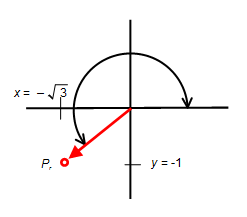How do you convert #(-sqrt 3, -1) # into polar coordinates?
1 Answer
Explanation:
Polar coordinates consist of the length if the arm from the origin to the point and the angle of that 'arm' measured from the
Using Pythagoras
'~~~~~~~~~~~~~~~~~~~~~~~~~~~~~~
The point
which is the 3rd quadrant

So the angle is
Thus the polar coordinate is
Or if you wish to use radians (
giving:

